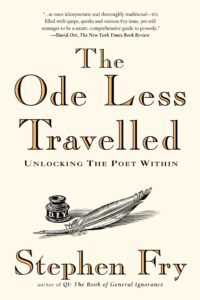Stephen Fry on Form, Part 2
 As I mentioned previously, I’m working through Stephen Fry’s The Ode Less Travelled very slowly to absorb as much wisdom as I can about writing poetry. This week’s post covers Chapter 3, Section 2, on stanzaic variations.
As I mentioned previously, I’m working through Stephen Fry’s The Ode Less Travelled very slowly to absorb as much wisdom as I can about writing poetry. This week’s post covers Chapter 3, Section 2, on stanzaic variations.
This section begins by introducing the names for various types of stanzas–tercets, quatrains, cinquains, and sixains–each of which can be used as the “form” for a poem. It then introduces some pairings of stanzas and rhyme schemes that are more specific forms–the terza rima, rubai, rhyme royal, ottava rima, and Spenserian stanza–giving examples of poems that are written in these forms.
One of the points Fry makes in this section is that the rhyme scheme, not the line length, defines these forms. You could write a poem in three line stanzas of iambic pentameter, but that’s not a terza rima. And a terza rima doesn’t have to be iambic pentameter, either. But it does have to have an aba bcb cdc … etc. rhyme scheme.
The only form in this chapter that has both a rhyme scheme and a line length requirement is the Spenserian stanza, which is eight lines of iambic pentameter, with the ninth (final) line in iambic alexandrine (12 syllables), following an ababbcbcc rhyme scheme. I’m glad this was the last form in the chapter, because at this point, my head is spinning a bit from the new forms and their varied rhyme schemes, none of which are the very basic abababab. But since I also feel like that rhyme scheme lends to poems that sound more childish, it’s probably a good thing to have some interesting rhyme schemes to play with in these forms.
The exercise for this section is to try out each of the specific forms, which I have not done yet, but am planning to do as I work on some new poems in the coming weeks!
Up next time is the ballad!

Comments